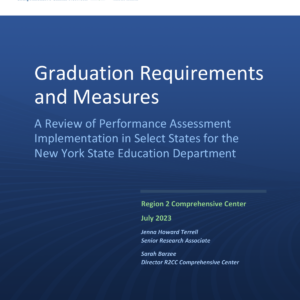A New Report Explores How States Approach Performance-Based Assessments
Posted on

Now available: a report on how states are using and operating performance-based assessments—including Colorado, Massachusetts, New Hampshire, Oregon, Rhode Island, Vermont, and Virginia.
On Nov. 13, New York’s Graduation Measures Blue Ribbon Commission presented recommendations to the New York Board of Regents on graduation requirements and measures that promote educational equity and ensure that New York’s students gain the knowledge and skills necessary to succeed as they prepare for college, career, and civic life.
A diverse cross-section of interest holders, including educators, administrators, researchers, school counselors, professionals from business and higher education, parents, and students, undertook an independent, thoughtful, and inclusive process to explore what a state diploma should signify to ensure educational excellence and equity for every student in New York State.
As part of the Commission’s extensive due diligence leading up to this task, the New York State Department of Education (NYSED) commissioned a landscape scan of the ways in which states are using performance-based assessments (PBAs) as part of their assessment strategies, as well as an examination of implementation processes, successes, areas for improvement, and lessons learned for the entire K–12 field. The federally funded Region 2 Comprehensive Center (R2CC), which provides technical assistance and capacity building to Connecticut, New York, and Rhode Island, conducted the research and prepared the report.
On September 18, NYSED publicly released the new report titled Graduation Requirements and Measures: A Review of Performance Assessment Implementation in Select States. The 42-page report, led by Jenna Terrell, a senior research associate at WestEd, is based on interviews and focus groups with state education department staff and consortium leaders across the country.
“As states like New York and districts across the nation continue to evaluate how to optimize measures of student performance,” says Sarah Barzee, director of R2CC, “this report offers insights regarding what is known to date about how this approach varies and is occurring through policy and practice by states and local districts.”
Terrell notes that while the scan shows commonalities across state PBA usage, it also unearths variation. For example, she says, whereas all state representatives interviewed indicated that their states support locally developed PBAs rather than assessments developed by testing companies or by the state itself, there were differences in whether their states chose to make the assessments voluntary or mandatory. For example, Colorado offers students the option of taking PBAs. In Oregon and Virginia, PBAs are mandatory for students in certain grades.
This is perhaps the biggest single recommendation Terrell reports from analysis findings: “Take the time and effort to get teachers and leaders bought into the process. Provide the opportunity for them to personally discover the value of PBAs, understand what is being measured, see the assessment development process as high quality, calibrate the rubric, and receive associated professional learning.”
This is perhaps the biggest single recommendation Terrell reports from analysis findings: ‘Take the time and effort to get teachers and leaders bought into the process.’
A similar sentiment was reflected by interviewees featured in the scan: “[I]nvolving teachers in decision-making processes and providing them with resources, support, and time to create high-quality assessments and rubrics led to more buy-in from teachers as well as more valid and reliable performance assessment results,” said a state representative cited in the report. “Co-creation of assessments, resources, and rubrics among teachers and leaders was emphasized …. as a key component of implementing high-quality performance-based assessments.”
Graduation Requirements and Measures: A Review of Performance Assessment Implementation in Select States further details the following:
- examples of other states that either require PBAs or allow districts to voluntarily opt into PBAs
- how states and districts integrate PBAs into a broader assessment strategy
- for which subjects and at which grade levels PBAs are offered
- who develops PBAs
- how states are working to ensure PBAs are of high quality
- how states approach scoring PBAs, including whether a common scoring rubric exists
- systems that states have established to support districts and schools in ongoing PBA professional learning
- the importance of flexibility and local ownership in PBA implementation
- what factors lead to teacher and leader buy-in
- the connection between PBAs and equity
In October, Terrell presented the new scan at the National Association of State Boards of Education conference in San Diego. Terrell develops research and evaluation studies and leads data analysis for education research projects funded by the U.S. Department of Education, the National Science Foundation, and the National Institute of Justice.
The report comes on the heels of a 2022 R2CC report titled Graduation Requirements and Measures: A Review Conducted for the New York State Board of Regents and the New York State Education Department, which consists of a literature review, state and international policy and practice scans, and qualitative analysis of stakeholder input obtained from throughout the state through regional meetings and other information gathering online.
The contents of this post were developed by the Region 2 Comprehensive Center. The Region 2 Comprehensive Center is funded by a grant from the U.S. Department of Education. However, the contents of this post do not necessarily represent the policy of the Department of Education, and you should not assume endorsement by the federal government.

